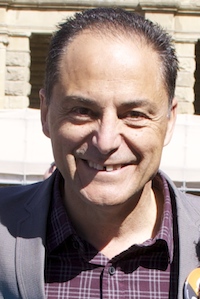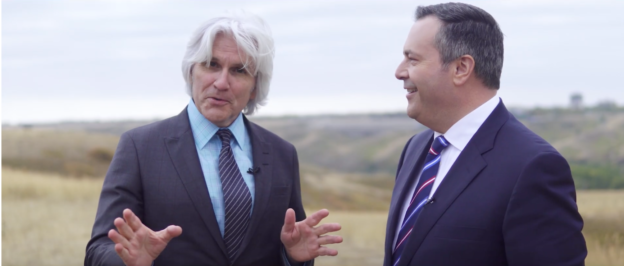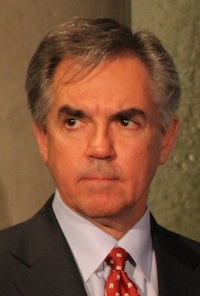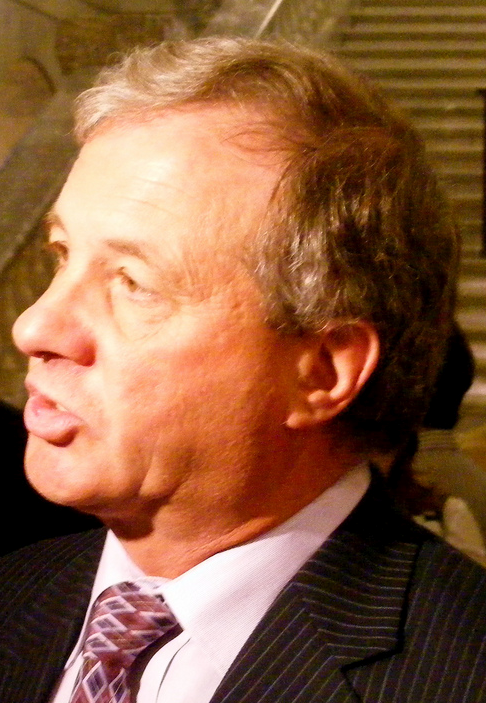The Alberta government’s much talked about energy war room now has its General. Energy Minister Sonya Savage announced yesterday that Tom Olsen has been hired as the managing director of the newly incorporated Canadian Energy Centre. The $30-million publicly funded private corporation is part of the UCP’s “fight back strategy” to counter claims made by critics of the oil and gas industry that Premier Jason Kenney said will target politicians, media and other opinion leaders, and could include satellite offices overseas.

Olsen was most recently the United Conservative Party candidate in the downtown Calgary-Buffalo riding in the 2019 provincial election, where he finished 9 per cent short of unseating former New Democratic Party finance minister Joe Ceci. But despite his recent electoral loss, Olsen has been a fixture of Conservative politics in Alberta for more than a decade.
After years as a columnist and reporter for the large daily newspapers in Calgary and Edmonton, Olsen jumped into politics when he was hired as Premier Ed Stelmach’s spokesperson in 2007. (Olsen’s brother, Gordon Olsen, worked in senior roles in the Premier’s Office while Ralph Klein occupied the office).
While some Albertans will remember Olsen for his role in the Northumberland beach photos fiasco, he also oversaw the launch of the first version of the war room.
In 2008, the Alberta government launched a website called “For the Record” that was dedicated to correcting what the government determined was incomplete or incorrect information in the media. “It’s not a forum to argue philosophy and spin. . . it’s not debating the rightness or wrongness of a particular issue. It’s about factual information,”Olsen told the Calgary Herald in December 2008. “I don’t see it as government policing journalists.”

It was the government policing journalists, and it did not last very long. The government website posted six corrections to news stories from various media outlets between November 2008 and December 2010. The website briefly became a source of controversy when Olsen insisted the Globe & Mail be referred to as the Toronto Globe & Mail. The website was later edited to drop Toronto from the newspaper’s name.
Following a wholesale purge of Stelmach’s senior communications staff, Olsen was whisked off to Vancouver to handle the Alberta government’s public relations during the 2010 Winter Olympics, which included the renting of the luxury Rocky Mountaineer train and the distribution of free iPads to journalists and VIPs.

Olsen later worked as a lobbyist for groups including the Calgary Residential Rental Association, Greyhound and the national group representing Pay Day Loan companies. He found himself back in the Progressive Conservative Party fold when he became Vice-President of Communications during Jim Prentice‘s brief time as party leader.
Savage, a former pipeline lobbyist and now a member of the war room board of directors along with Justice Minister Doug Schweitzer and Environment and Parks Minister Jason Nixon, said this week that the war room will include a rapid response centre, an energy literacy unit and a data research unit. Former Postmedia columnist Claudia Cattaneo was hired in August 2019 by the government to write the Energy War Room Strategic plan.
Earlier this year, Postmedia hired Kenney’s former chief of staff, Nick Koolsbergen, to lobby the UCP government on ways the Toronto-headquartered newspaper company could be involved with the war room.
In an interview with the Postmedia-owned Financial Post, Postmedia President and CEO Andrew MacLeod said that the lobby effort was part the company’s effort to find new revenue streams and that it had no relationship to editorial decision-making (meanwhile, the front cover of the Postmedia-owned National Post today featured a paid political advertisement attacking Prime Minister Justin Trudeau).

The Canadian Association of Petroleum Producers, a lobby group that represents many of Canada’s oil and gas companies, is also registered to lobby Alberta MLAs, the Minister of Energy and the Premier’s Office to share and advise on best practices for the war room to counter misinformation.
Postmedia’s past relationship with CAPP is no secret, but these group’s business relationships with the war room could be.
As CBC’s Michelle Bellefontaine reported today, as a private corporation the Canadian Energy Centre will be exempt from freedom of information requests, meaning that Albertans might not ever know how much of the $30 million is paid to Postmedia, CAPP or whichever UCP-connected PR firms are hired to work for the publicly-funded private war room.
Regardless of which PR companies or Toronto-based newspaper company gets hired, Olsen will have his job cut out for him. The first order of business for the new Canadian Energy Centre might be playing defence for the Alberta government’s $2.5 million public inquiry into anti-oil campaigns – an effort that has been criticized as a witch-hunt by groups like EcoJustice and the venerable Amnesty International.
While it may be easy for Kenney to dismiss NGOs and suggest that the 4,000 Albertans participating in the climate strike protest outside the Legislature were communist sympathizers, Olsen’s war room will have a harder time dismissing its greatest opponent – the free market.
Many major international oil and gas corporations have withdrawn their investments in Canada’s oilsands over the past five years, and the UCP’s decision to scale back the Alberta government’s climate change commitments certainly will not help how our province is perceived internationally.
Conservatives howled loudly this week as a major Norwegian pension fund withdrew investments in four Alberta-based oilsands companies. The move was described by UCP supporters online as hypocritical, as Norway continues to make investments in its own off-shore oil and gas platforms. The move may have been hypocritical, but those are the types of decisions that countries like Norway can make when they have $1.1 trillion saved in the bank (something for Albertans to think about when they consider how much past governments have squandered our wealth).
Olsen’s biggest challenge might be to prove that the war room is more than a $30-million public relations subsidy to Alberta’s oil and gas companies.
Public attitudes toward fossil fuels and climate change are shifting dramatically, and Alberta risks becoming increasingly isolated on energy and climate issues on the national and international stage. Judging from the Alberta government’s numerous high-profile efforts over the past two decades to correct what it saw as misinformation about the oilsands and fight environmental advocates outside the province, the war room might be an example of the UCP preparing to fight the last war.
A short history of Alberta government advertising campaigns and initiatives aimed at critics of oil and gas companies (I am sure I have missed a few):
2002: the Alberta government announced and later scrapped plans for an anti-Kyoto Accord advertising campaign in Ontario after focus group testing proved the messaging was unpopular among Torontonians.
2008: the Alberta government launched a public relations campaign targeting critics of the oilsands outside of Alberta, which included a 20-page glossy brochure entitled Alberta’s Oil Sands: Balance. Opportunity. This campaign included a North America and European speaking tour by the Premier.
2010: the Alberta government rolled out a slick $25-million “Tell It Like It Is” oilsands promotional campaign that included advertisements in London’s Piccadilly Circus and New York City’s Times Square. The multimedia blitz includes CDs and DVDs about “Alberta’s Clean Energy Future” and “A conversation on oilsands and the environment” – which features commentary from provincial experts.
2012: the Alberta government announced it was spending $77,000 on a pro-Keystone XL Pipeline advertising campaign during the Premier’s visit to Washington DC and hired lobbyists to directly lobby US officials.
2012: the federal Conservative government assigned Canadian diplomats to lobby Fortune 500 companies in the U.S. in order to counter campaigns launched by an environmental advocacy groups targeting the oilsands.
2013: the federal Conservative government launched a advertising campaign directed at American politicians ahead of Prime Minister Stephen Harper’s trip to the United States. The ad campaign described Canada as a “world environmental leader” on oil and gas development.
2018: the Alberta government spent more than $23 million promoting its KeepCanadaWorking advertising campaign in support of the expansion of the Trans Mountain PIpeline from Alberta to British Columbia.











